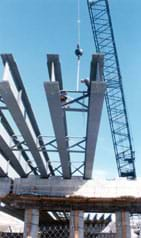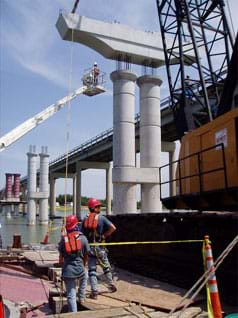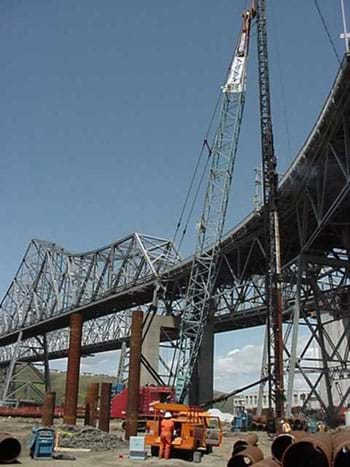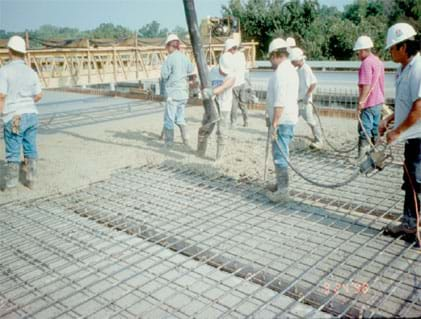
Summary
Students learn about the many types of expenses associated with building a bridge. Working like engineers, they estimate the cost for materials for a bridge member of varying sizes. After making calculations, they graph their results to compare how costs change depending on the use of different materials (steel vs. concrete). They conclude by creating a proposal for a city bridge design based on their findings.Engineering Connection
Bridges are big projects in our world, and they are often municipal projects that we all pay for with our taxes. Engineers are involved in all phases of bridge design and creation, including their projected cost. Engineers make comparative cost analyses with the objective to determine the optimum choices in materials, design and construction process. The many different components of a cost analysis affect the amount of freedom that engineers have to produce a completed product. Then engineers work collaboratively with a team of people to make sure the design is completed in a timely manner within budget.
Learning Objectives
After this activity, students should be able to:
- List several factors that influence the cost of a bridge.
- Estimate the costs of model bridge project.
- Describe the importance for engineers of balancing the cost of the bridge with the design of the bridge.
Educational Standards
Each TeachEngineering lesson or activity is correlated to one or more K-12 science,
technology, engineering or math (STEM) educational standards.
All 100,000+ K-12 STEM standards covered in TeachEngineering are collected, maintained and packaged by the Achievement Standards Network (ASN),
a project of D2L (www.achievementstandards.org).
In the ASN, standards are hierarchically structured: first by source; e.g., by state; within source by type; e.g., science or mathematics;
within type by subtype, then by grade, etc.
Each TeachEngineering lesson or activity is correlated to one or more K-12 science, technology, engineering or math (STEM) educational standards.
All 100,000+ K-12 STEM standards covered in TeachEngineering are collected, maintained and packaged by the Achievement Standards Network (ASN), a project of D2L (www.achievementstandards.org).
In the ASN, standards are hierarchically structured: first by source; e.g., by state; within source by type; e.g., science or mathematics; within type by subtype, then by grade, etc.
NGSS: Next Generation Science Standards - Science
| NGSS Performance Expectation | ||
|---|---|---|
|
MS-ETS1-2. Evaluate competing design solutions using a systematic process to determine how well they meet the criteria and constraints of the problem. (Grades 6 - 8) Do you agree with this alignment? |
||
| Click to view other curriculum aligned to this Performance Expectation | ||
| This activity focuses on the following Three Dimensional Learning aspects of NGSS: | ||
| Science & Engineering Practices | Disciplinary Core Ideas | Crosscutting Concepts |
| Evaluate competing design solutions based on jointly developed and agreed-upon design criteria. Alignment agreement: | There are systematic processes for evaluating solutions with respect to how well they meet the criteria and constraints of a problem. Alignment agreement: | |
| NGSS Performance Expectation | ||
|---|---|---|
|
MS-ETS1-4. Develop a model to generate data for iterative testing and modification of a proposed object, tool, or process such that an optimal design can be achieved. (Grades 6 - 8) Do you agree with this alignment? |
||
| Click to view other curriculum aligned to this Performance Expectation | ||
| This activity focuses on the following Three Dimensional Learning aspects of NGSS: | ||
| Science & Engineering Practices | Disciplinary Core Ideas | Crosscutting Concepts |
| Develop a model to generate data to test ideas about designed systems, including those representing inputs and outputs. Alignment agreement: | Models of all kinds are important for testing solutions. Alignment agreement: The iterative process of testing the most promising solutions and modifying what is proposed on the basis of the test results leads to greater refinement and ultimately to an optimal solution.Alignment agreement: | |
Common Core State Standards - Math
-
Fluently divide multi-digit numbers using the standard algorithm.
(Grade
6)
More Details
Do you agree with this alignment?
-
Fluently add, subtract, multiply, and divide multi-digit decimals using the standard algorithm for each operation.
(Grade
6)
More Details
Do you agree with this alignment?
-
Solve unit rate problems including those involving unit pricing and constant speed.
(Grade
6)
More Details
Do you agree with this alignment?
-
Use ratio reasoning to convert measurement units; manipulate and transform units appropriately when multiplying or dividing quantities.
(Grade
6)
More Details
Do you agree with this alignment?
-
Recognize and represent proportional relationships between quantities.
(Grade
7)
More Details
Do you agree with this alignment?
-
Construct and interpret scatter plots for bivariate measurement data to investigate patterns of association between two quantities. Describe patterns such as clustering, outliers, positive or negative association, linear association, and nonlinear association.
(Grade
8)
More Details
Do you agree with this alignment?
International Technology and Engineering Educators Association - Technology
-
Students will develop an understanding of the relationships among technologies and the connections between technology and other fields of study.
(Grades
K -
12)
More Details
Do you agree with this alignment?
-
The selection of designs for structures is based on factors such as building laws and codes, style, convenience, cost, climate, and function.
(Grades
6 -
8)
More Details
Do you agree with this alignment?
State Standards
American Association for the Advancement of Science - Science
-
New ideas in science are limited by the context in which they are conceived; are often rejected by the scientific establishment; sometimes spring from unexpected findings; and usually grow slowly, through contributions from many investigators.
(Grades
9 -
12)
More Details
Do you agree with this alignment?
Colorado - Math
-
Estimate and compute unit cost of consumables (to include unit conversions if necessary) sold in quantity to make purchase decisions based on cost and practicality
(Grade
7)
More Details
Do you agree with this alignment?
-
Represent data on two quantitative variables on a scatter plot, and describe how the variables are related.
(Grades
9 -
12)
More Details
Do you agree with this alignment?
Colorado - Science
-
Predict and evaluate the movement of an object by examining the forces applied to it
(Grade
8)
More Details
Do you agree with this alignment?
Materials List
Each group needs:
- pencil and eraser
- calculator
- Cost Comparisons Worksheet
- Bridge Proposal Worksheet
Worksheets and Attachments
Visit [www.teachengineering.org/activities/view/cub_brid_lesson05_activity1] to print or download.Pre-Req Knowledge
Students should have some previous knowledge of bridges, including a familiarity with bridge types and parts of a bridge, as introduced in other lessons in the Bridges unit.
Introduction/Motivation
Every community has bridges and the stories behind how these bridges get built reveal the creative ways humans come together to accomplish big projects. Who pays for bridges? Do we care how much they cost? When we make plans for a big project, considering costs is one important aspect that engineers consider, but since we're all paying for these bridges, it is important to all of us, too. So today, just like engineers, let's discuss the factors that influence cost, what goes into calculating the total cost of a bridge, and the value of optimizing the cost and design of the bridge.

Several factors influence bridge cost. What comes to mind? (Write student suggestions on the board, before moving on.) First (and sometimes foremost) is the type and amount of material used. With everything else being equal, a bridge with members that are half the size of another bridge is less expensive. Another important factor is the construction labor. In regions where the cost of labor is very expensive, this can become the most important factor in a bridge's cost. In this case, keeping labor costs down by using fewer bridge members can be cost effective. However, using fewer members may require them to be larger, which may affect the safety of the bridge design. More and more, the large steel and concrete members are being pre-fabricated off-site where labor costs are more affordable, and then the bridge is constructed on-site more quickly, with less disruption to the community.
What other factors might influence the total cost of creating a bridge? (Possible answers: Cost to transport materials [trucks, ferries], construction equipment [such as cranes], environmental and site studies, traffic re-routing, administrative expenses [engineers to design the bridge and oversee its construction].)

As you can imagine, the number of expenses that go into creating a real bridge makes a long list. For today's activity, we are going to simplify the process and consider only a few of the many expenses associated with the total cost of building a bridge, enough to do a general cost analysis.
First, let's consider the cost of the material used. How do you think we figure out how much material we are using? Calculating the volume of all of the parts of the bridge gives the total amount of material in the bridge. The cost of the material is usually calculated by its amount or weight. Then, we multiply the amount of material volume by the cost of material per volume to get the entire cost of the material. The cost of labor and equipment are also both major cost components to include. A site investigation must also be included as part of determining the final design. Finally, administrative expenses must be included, too.
Do we care how much bridges cost? Why not build them all the same? Why not build them all to accomplish the same purpose? Would we want that? Probably not. So, every bridge is customized (unique) for its specific purpose and location. Once engineers figure out the known costs for research, materials, labor, equipment, transportation and administration, they must optimize or find the best design to fit the given budget. Optimizing the design produces the most cost-efficient and effective design.
Today, the city of Needabridge issued a request for proposals to create a new transportation bridge connecting their city to another city across the river. Working in engineering teams, we will prepare a proposed budget for building their bridge. We will estimate the amount of materials required to make a bridge member (a girder or beam) out of concrete and again out of steel. From this, we'll calculate the costs to make it for different girder sizes. We will graph the results and prepare a proposal for Needabridge city planners to pitch our design to be the one that is chosen for their new bridge.
Procedure
Before the Activity
- Make copies of the Cost Comparisons Worksheet and Bridge Proposal Worksheet, one per team.
- Make sure each student has a pencil, eraser and calculator.
- Divide the class into teams of two students each.
With the Students
- Before handing out the worksheets, review with students the key factors that influence the total cost of constructing a bridge. Explain that today they will be solving for the cost of a concrete and steel girder used in a bridge. For two different materials, they will determine how the size of the girder changes the cost of the girder. They will use this information to create a mock budget proposal for the town of Needabridge.
- Hand out the Cost Comparison Worksheets to student teams. Have them begin by calculating the volume of material for each type of beam.
- Next, have students complete the charts by filling in the cost per beam of concrete or steel.
- Next, have students graph their results.
- Engage the class in a discussion to compare worksheet results. Compare the different costs of the girder and how the cost changes depending on its material and size.
- Finally, have student teams complete the Bridge Proposal Worksheet. This includes creating an engineering firm name, sketching their bridge design, estimating the cost of materials, equipment and labor for the project, and explaining why their design should be chosen.
- If time permits, have student teams present their proposals to the class.
Vocabulary/Definitions
budget: The amount of money available for a project, such as creating a bridge.
cost: The amount of money needed to build a project, such as a bridge.
design: (verb) To plan out in systematic, often graphic form. To create for a particular purpose or effect. Design a bridge. (noun) A well thought-out plan.
engineer: A person who applies her/his understanding of science and mathematics to creating things for the benefit of humanity and our world.
engineering: Applying scientific and mathematical principles to practical ends such as the design, manufacture and operation of efficient and economical structures, machines, processes and systems.
estimating: An accurate determination of the cost of the project (such as a bridge) before construction begins.
girder: The "beam" of a bridge; usually a horizontal member.
member: An individual angle, beam, column, plate or built piece intended to become an integral part of an assembled frame or structure.
optimal design: Balancing the cost and design of the bridge so that the least amount of money accomplishes the required task effectively.
pier: The "column" of a bridge; usually a vertical member.
Assessment
Pre-Activity Assessment
Discussion Questions: Ask students to estimate the cost of concrete per unit volume (such as cubic yard or cubic meter). Write their guesses on the board. Ask them to estimate the cost of steel per unit volume (such as per ton). Write their estimates on the board. Give the correct answers (concrete = $65 per cubic yard; steel = $2,000 per ton).
Activity Embedded Assessment
Worksheet: Have students use the attached Cost Comparisons Worksheet to complete the activity. Review their answers to gauge their mastery of the subject.
Discussion Questions: As a class, compare worksheet results. Discuss and compare the different costs of the girders. How did the cost change depending on the material and size? (Answer: Costs are more expensive with steel than concrete. Costs increase with the length of the girder. Sometimes engineers combine steel and concrete (reinforced concrete) to make girders that are strong like steel, but cost less. Engineers also design girders that are not solid rectangular beams, such as I-shaped beams and trusses that use less material and weigh less.)
Post-Activity Assessment
Engineering Proposal: Direct student teams to complete the attached Bridge Proposal Worksheet. If time permits, have each team present their proposals to the class. Have the class act as the city planning commission and vote on the designs, and have the teacher be the mayor of Needabridge, asking questions about the design ideas.
Troubleshooting Tips
If students have difficulty with the worksheet calculations, provide an example problem on the board for the entire class, or pair stronger students with those needing assistance.
Activity Extensions

Have students estimate the cost of a classmate's bridge design and compare the differences in their calculations in the final cost, if any.
Have students model bridge costs for a variety of bridge scenarios. How would the amount of materials change in each scenario? Would the girders, piers and foundations be different? Examples might include:
- A railway bridge across a deep ravine, 300 feet across
- A pedestrian / bicycle bridge over a highway
- A pedestrian bridge over a pond at a local park
Activity Scaling
- For lower grades, complete the worksheet together, as a class.
- For upper grades, have each student research the cost of labor for the use of steel and concrete. Have them determine what percentage of the cost used in the worksheet is for materials cost and what percentage of the cost is for labor cost.
Subscribe
Get the inside scoop on all things TeachEngineering such as new site features, curriculum updates, video releases, and more by signing up for our newsletter!More Curriculum Like This

Students learn about the major factors that comprise the design and construction cost of a modern bridge. Students learn about the components that go into estimating the total cost, including expenses for site investigation, design, materials, equipment, labor and construction oversight, as well as ...

Students are presented with a brief history of bridges as they learn about the three main bridge types: beam, arch and suspension. They are introduced to two natural forces — tension and compression — common to all bridges and structures.

Students learn about the variety of materials used by engineers in the design and construction of modern bridges. They also find out about the material properties important to bridge construction and consider the advantages and disadvantages of steel and concrete as common bridge-building materials ...

Students learn about the types of possible loads, how to calculate ultimate load combinations, and investigate the different sizes for the beams (girders) and columns (piers) of simple bridge design. Additionally, they learn the steps that engineers use to design bridges.
References
Ralls, Mary Lou. The Future is Now... Successes in Bridge Construction. Presented January 12, 2005, TRB 2005, Session 628. Highways for Life, Federal Highway Administration, US Department of Transportation. Accessed October 16, 2007. (Photos and information about bridges under construction, the movement of structural members to the site, and efforts to reduce construction impact on traffic and the environment) http://www.fhwa.dot.gov/hfl/ralls.cfm
Copyright
© 2006 by Regents of the University of Colorado.Contributors
Jonathan S. Goode; Joe Friedrichsen; Natalie Mach; Denali Lander; Denise W. Carlson; Malinda Schaefer ZarskeSupporting Program
Integrated Teaching and Learning Program, College of Engineering, University of Colorado BoulderAcknowledgements
The contents of this digital library curriculum were developed under a grant from the Fund for the Improvement of Postsecondary Education (FIPSE), U.S. Department of Education and National Science Foundation GK-12 grant no. 0338326. However, these contents do not necessarily represent the policies of the Department of Education or National Science Foundation, and you should not assume endorsement by the federal government.
Last modified: March 19, 2018











User Comments & Tips